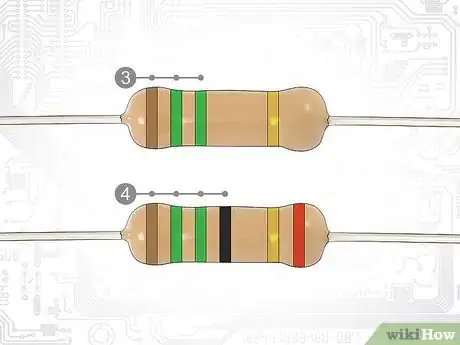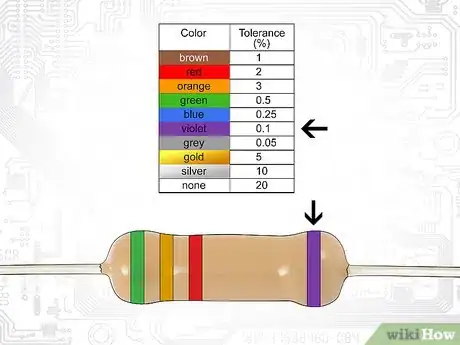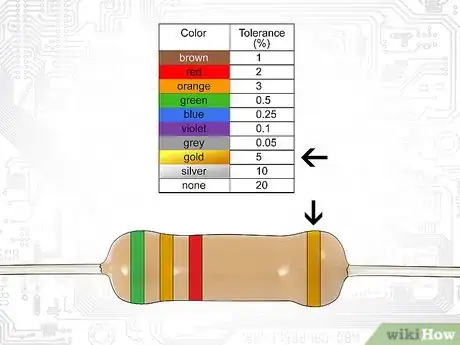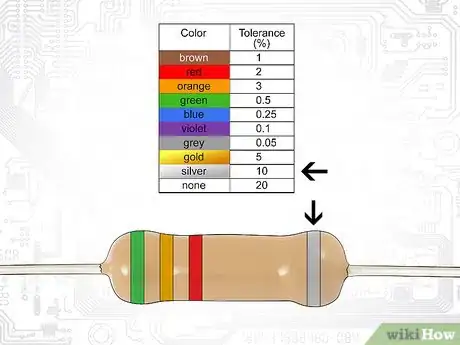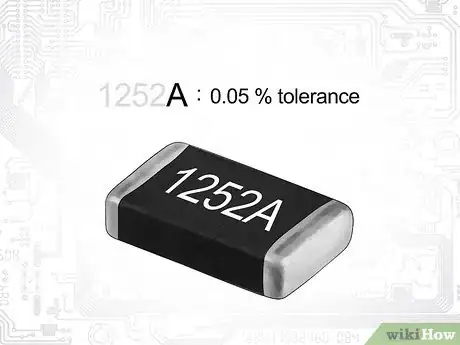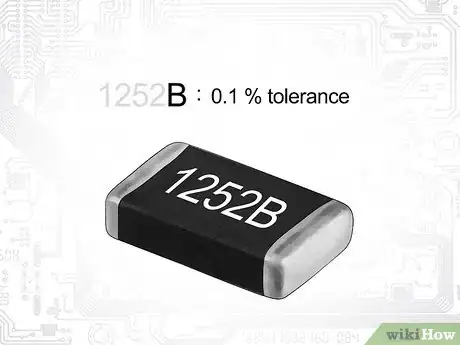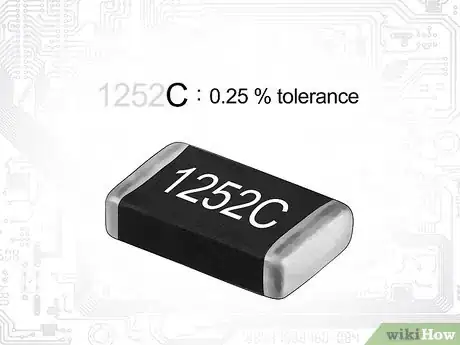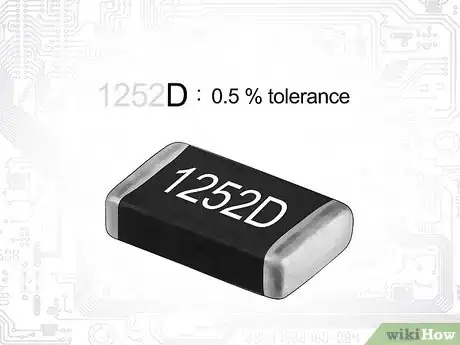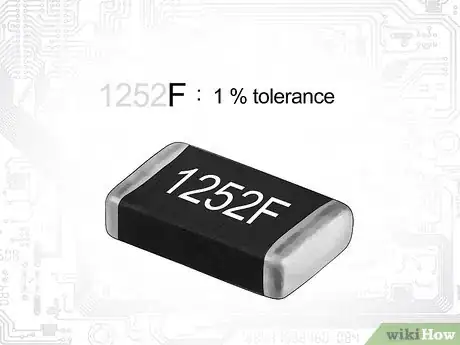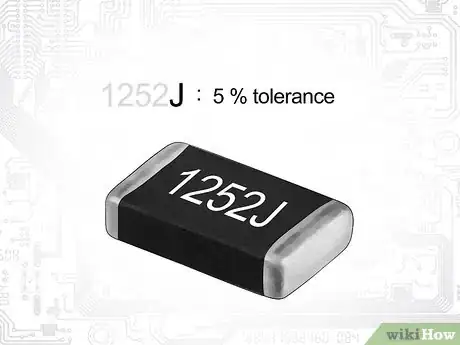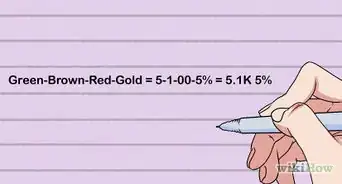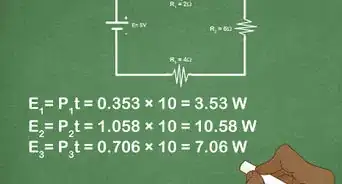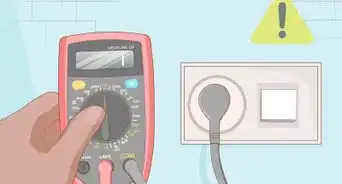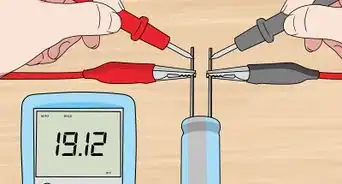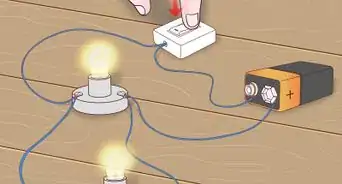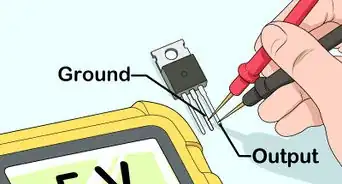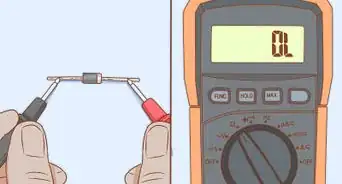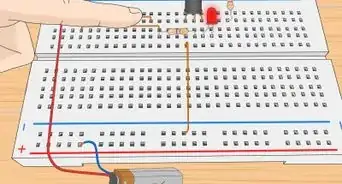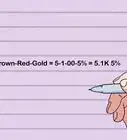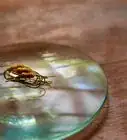This article was co-authored by wikiHow Staff. Our trained team of editors and researchers validate articles for accuracy and comprehensiveness. wikiHow's Content Management Team carefully monitors the work from our editorial staff to ensure that each article is backed by trusted research and meets our high quality standards.
This article has been viewed 216,275 times.
Learn more...
Resistors are very common components in electronic circuits of all kinds. Their function is to resist the current flowing in the circuit, and how much resistance they provide is measured in ohms. Most are printed with either a color code or an alphanumeric code to indicate their ohmic value and tolerance -- how much their resistance may vary. Learning the codes, along with using a helpful mnemonic device, will allow you to identify resistors easily.
Steps
Color Coded Resistors (Axial Resistors)
-
1Axial resistors are cylindrical with leads extending from each end.
-
2Look at the resistor so the group of 3 or 4 color bands are on the left side. These are sometimes followed by a gap, then an additional color band.[1]Advertisement
-
3Read the color bands from left to right. The colors on the first 2 or 3 bands correspond to numbers from 0 to 9, which represent the significant digits of the resistor's ohmic value. The last band gives the multiplier. For example, a resistor with brown, green and green bands is rated at 15 mega-ohms (15,000,000 ohms). The code is as follows:[2]
- Black: 0 significant digit, multiplier of 1
- Brown: 1 significant digit, multiplier of 10
- Red: 2 significant digit, multiplier of 100
- Orange: 3 significant digit, multiplier of 1,000 (kilo)
- Yellow: 4 significant digit, multiplier of 10,000 (10 kilo)
- Green: 5 significant digit, multiplier of 100,000 (mega)
- Blue: 6 significant digit, multiplier of 1,000,000 (10 mega)
- Violet: 7 significant digit
- Gray: 8 significant digit
- White: 9 significant digit
- Gold: multiplier of 1/10
- Silver: multiplier of 1/100
-
4Read the color on the last color band, which is farthest right. This represents the tolerance of the resistor. If there is no color band, the tolerance is 20 percent. Most resistors have no band, a silver band or a gold band, but you may find resistors with other colors. The tolerance color code is as follows:[3]
-
5Brown: 1 percent tolerance
-
6Red: 2 percent tolerance
-
7Orange: 3 percent tolerance
-
8Green: 0.5 percent tolerance
-
9Blue: 0.25 percent tolerance
-
10Violet: 0.1 percent tolerance
-
11Gray: 0.05 percent tolerance
-
12Gold: 5 percent tolerance
-
13Silver: 10 percent tolerance
-
14Memorize a mnemonic for resistors. Several exist, so choose the one that you won't forget. Remember that the first color is black, and afterward each first letter corresponds to a color in order from 0 to 9. Some popular mnemonic devices include:[4]
- "Bad beer rots our young guts but vodka goes well."
- "Bright boys rave over young girls but veto getting wed."
Alphanumerically Coded Resistors (Surface Mounted Resistors)
-
1Surface mounted resistors are rectangular in shape with leads that extend from opposite sides or the same side and are bent downward for mounting on circuit boards. Some resistors have contact plates on the bottom.[5]
-
2Read the 3 or 4 numbers on the resistor. The first 2 or 3 represent the significant digits and the last indicates the number of 0s that should follow. For example, a resistor reading 1252 indicates a rating of 12,500 ohms or 1.25 kilo-ohms.[6]
-
3Compare the letter at the end of the code with the tolerance it represents.[7]
-
4A: 0.05 percent tolerance
-
5B: 0.1 percent tolerance
-
6C: 0.25 percent tolerance
-
7D: 0.5 percent tolerance
-
8F: 1 percent tolerance
-
9G: 2 percent tolerance
-
10J: 5 percent tolerance
-
11K: 10 percent tolerance
-
12M: 20 percent tolerance
-
13Check to see if there is a letter "R" within the numeric code. This indicates a very small resistor, and the letter takes the place of a decimal point. For instance, a 5R5 resistor is rated at 5.5 ohms.[8]
Community Q&A
Did you know you can get answers researched by wikiHow Staff?
Unlock staff-researched answers by supporting wikiHow
-
QuestionWhat color is a 2.2 K ohm resistor?
 wikiHow Staff EditorThis answer was written by one of our trained team of researchers who validated it for accuracy and comprehensiveness.
wikiHow Staff EditorThis answer was written by one of our trained team of researchers who validated it for accuracy and comprehensiveness.
Staff Answer wikiHow Staff EditorStaff Answer
wikiHow Staff EditorStaff Answer -
QuestionWhat is the “K” in a resistor?
 wikiHow Staff EditorThis answer was written by one of our trained team of researchers who validated it for accuracy and comprehensiveness.
wikiHow Staff EditorThis answer was written by one of our trained team of researchers who validated it for accuracy and comprehensiveness.
Staff Answer wikiHow Staff EditorStaff Answer
wikiHow Staff EditorStaff Answer -
QuestionWhat are the 4 types of resistors?
 wikiHow Staff EditorThis answer was written by one of our trained team of researchers who validated it for accuracy and comprehensiveness.
wikiHow Staff EditorThis answer was written by one of our trained team of researchers who validated it for accuracy and comprehensiveness.
Staff Answer wikiHow Staff EditorStaff Answer
wikiHow Staff EditorStaff Answer
References
- ↑ https://www.jameco.com/Jameco/workshop/circuitnotes/circuit-notes-resistors.html
- ↑ https://www.digikey.com/en/resources/conversion-calculators/conversion-calculator-resistor-color-code-4-band
- ↑ https://www.digikey.com/en/resources/conversion-calculators/conversion-calculator-resistor-color-code-4-band
- ↑ https://www.arrow.com/en/research-and-events/articles/resistor-color-code
- ↑ https://www.diyaudioandvideo.com/Electronics/ResistorColorCodes/
- ↑ https://www.diyaudioandvideo.com/Electronics/ResistorColorCodes/
- ↑ http://apps.usd.edu/coglab/psyc770/resistors/r4beginner.html
- ↑ http://apps.usd.edu/coglab/psyc770/resistors/r4beginner.html
About This Article
To identify resistors, first look at the shape of the resistors to find out which type they are. Axial resistors are cylindrical with a group of color bands, while surface mounted resistors are rectangular with alphanumeric codes. For axial resistors, read the color bands from left to right which will tell you the ohmic value, multipliers, and tolerance. To help you remember each color’s value, memorize a mnemonic like “Bad beer rots our young guts but vodka goes well.” To learn more, like what numbers go with each color and how to read surface mounted resistors, scroll down!

